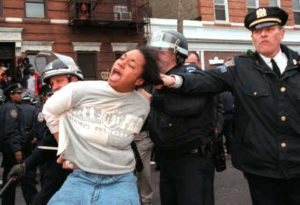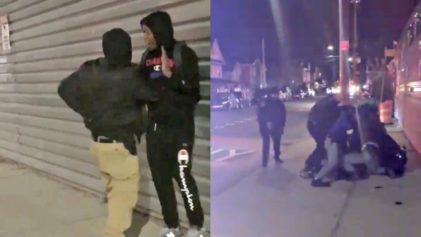
While the city’s violent crime rate has declined significantly over that time period, the numbers reveal how the actions of the police in the nation’s most populous city have negatively affected the lives of people of color, in the process serving to further sour the relationship between the cops and Black and Hispanic communities.
Researchers from the city’s John Jay College for Criminal Justice conducted a study looking at the arrests for misdemeanors since 1980, discovering that the percentage of New Yorkers arrested for misdemeanors has tripled over that time. But the brunt of those arrests has not been borne equally across the city population.
The number of Blacks arrested for misdemeanors nearly doubled to 104,659 in 2013, from 56,152 in 1990. The numbers rose even more dramatically for Hispanics, from 30,885 in 1990 to 78,733 in 2013. During the same period, 28,996 whites were arrested for misdemeanors in 2013, compared to 21,815 in 1990.
The authors of the report, Jeremy Travis, president of John Jay College for Criminal Justice, and Preeti Chauhan, a professor of psychology, also analyzed data from Buffalo, Rochester and other urban centers in New York state and found similar patterns in those cities.
“The findings highlight what we see as the stark racial biases that are endemic to police practices in New York City,” Robert Gangi, director of the Police Reform Organizing Project, an advocacy group aimed at exposing unjust police practices, told the Huffington Post.
In the eyes of many observers, it was the police department’s crackdown on misdemeanors that led to the death of Eric Garner in Staten Island, who was killed by police when he was put in a chokehold after officers confronted him about selling loose cigarettes without a permit.
The New York Daily News in September published the results of an investigation revealing that African-Americans and Hispanics are vastly more likely than whites to be targeted by police for quality-of-life offenses, even in neighborhoods with relatively low Black and Hispanic populations.
The Daily News concluded that this racist enforcement of the New York Police Department policy has created “a tale of two cities, one primarily populated by whites, where minor infractions like drinking on a stoop or smoking a joint are rarely punished, and another, primarily populated by blacks and Hispanics, where walking down the street could be cause for interrogation.”
New York City’s so-called “broken windows” theory of policing — cracking down on minor infractions such as loitering or drinking in public with the expectation that it will prevent major crimes from happening — has been a staple of the NYPD ever since the administration of Mayor Rudy Giuliani in the 1990s. The approach drew increased scrutiny with the explosion in the use of the controversial stop-and-frisk policy during the administration of Michael Bloomberg.
While Police Commissioner Bill Bratton told a City Council in September that Blacks and Hispanics receive a disproportionate number of summonses because cops are concentrating their efforts on “the most problematic areas of the city,” the Daily News report directly refutes that statement.
By comparing the percentage of summonses received by Blacks and Hispanics in each neighborhood with their percentage of the population there, the Daily News analysis shows that the summonses seem to follow Blacks and Hispanics wherever they go — even to neighborhoods where they are dramatically underrepresented.
Gangi’s Police Reform Organizing Project released its own study Tuesday, analyzing the racial makeup of defendants in court hearings throughout the city. The 11-page report noted that on Sept. 19, 46 of the 47 defendants at Brooklyn’s Criminal Court were people of color — commonly charged for such low level offenses as marijuana possession, carrying an open alcohol container, and driving with a suspended license. Overall, 173 people, or 91 percent of the 191 defendants, were people of color and a vast majority, 163, or 85 percent of those arraigned, walked out of the courtroom because the charge was dismissed or a minor penalty meted out.
To a large extent, the city’s court system has become an assembly line to process Black and Hispanic New Yorkers.
“The court had clearly decided that the person was not a risk to the community,” the report said. “This kind of policing – effectively criminalizing activities that are victimless, and seen by most people as harmless, and disproportionately charging one group of persons as offenders – breeds cynicism, resentment and resistance and can lead, in worst case scenarios to senseless injury and death.”
“We certainly support having the police assigned to areas where criminal acts are prevalent,” Gangi told the Huffington Post. “The problem is so much of what the police engage in is not responding to crimes.”
For example, he pointed out the 191 people arrested included those charged with riding a bicycle on a sidewalk, putting a foot on a subway seat and sleeping on a park bench.


